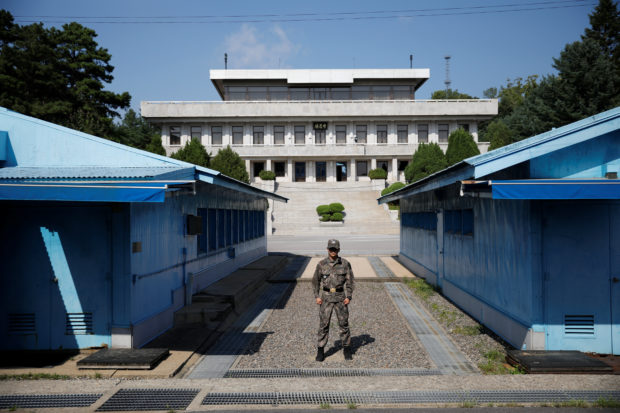
A South Korean soldier stands guard in the truce village of Panmunjom inside the demilitarized zone (DMZ) separating the two Koreas, South Korea, August 28, 2019. REUTERS FILE PHOTO
SEOUL — South and North Korea reopened their hotlines on Tuesday after a yearlong communications vacuum that had flared tensions and soured relations.
At least 49 hotlines have been set up between the two Koreas since the 1970s, and Seoul sees them as a crucial tool to prevent misunderstandings from unexpected military developments, especially along their shared heavily fortified demilitarized zone (DMZ).
The lines were also meant to arrange diplomatic meetings, coordinate air and sea traffic, facilitate humanitarian discussions, minimize impacts from natural disasters and cooperate on economic issues.
But the isolated North has often cut the channels in times of strained ties, especially when negotiations aimed at dismantling its nuclear and missile programs collapsed.
North Korea severed the hotlines on June 9, 2020, in the wake of a failed February 2019 summit between North Korean leader Kim Jong Un and former U.S. President Donald Trump, which South Korean President Moon Jae-in had offered to mediate.
South Korea had nonetheless kept trying to call every day at the same times, 9 a.m. and 4 p.m.
North Korea lashed out at Seoul, and days later, it blew up a joint liaison office launched in its border town of Kaesong in 2018.
That dealt a further blow to efforts to persuade Kim to abandon nuclear weapons, and Moon’s hopes of building peace with the erratic neighbor.
Before then, the hotlines were last cut in 2016 amid North Korean ballistic missile and nuclear tests. During that period, South Korean officials sometimes used a bullhorn to shout messages across the Joint Security Area (JSA) in Panmunjom, the only spot along the DMZ where troops from both sides stand face to face.
When the lines were restored in 2018, liaison officials spoke mostly using desktop telephone consoles dating to the 1970s, each the size of a small refrigerator. They would usually exchange brief greetings or notices, and fax machines were used to send detailed messages and documents, Seoul officials said.
The system features a computer screen, disk drives and USB ports, as well as two color-coded telephone handsets – a red phone to receive incoming calls from the North and a green one for outgoing calls. No other numbers can be called, as the phones only connect to each other’s counterpart.
All of the systems involve similar equipment, though newer systems were installed in 2009, according to the South’s Unification Ministry, which handles inter-Korean affairs and operates most of the hotlines.
The South Korean military has also released photos of its own small, olive-drab desktop phones labelled “two-sided inter-Korean hotline.”
Little is known about the North’s equipment.
Moon and Kim had agreed to open a direct line between their offices, but Seoul officials said in 2019 that it had never been used.